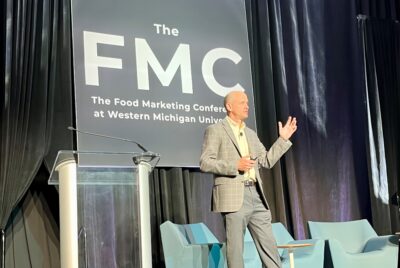Despite ongoing economic headwinds, convenience stores across the U.S. are finding new and innovative ways to lure passersby — a shift that’s redefining what people expect when they stop for gas, food and other c-store staples.
And though recent years have been difficult for all retailers, industry experts are downright giddy about the opportunities for c-stores. More than 20,000 retailers, vendors and attendees will soon converge on Las Vegas for the annual NACS Show October 7-10, to network, learn and conduct business. In the lead-up to the convention, there’s palpable excitement for what seems to be a full-on transformation in direct response to the challenges of recent years.
“We’re seeing a lot of activity in the c-store channel, from mergers and acquisitions to store expansions and more foodservice operations,” says Brenda Chantry, category manager, senior team leader at Advantage Solutions, a business solutions provider to consumer goods manufacturers and retailers.
But as in all retail, inflation has been the biggest issue. The number of store trips are down this year by about 3.5%, according to data from Circana, which also reports that the average price per unit in c-stores has outpaced all other multi-outlet brick-and-mortar channels.
Now the good news: Retailers and brands are finding new opportunities in a number of trends and developments that are growing their c-store business.
A changing landscape
The total number of convenience stores grew by 1.5% in 2023 for the second year in a row, according to NACS data, for a total of more than 152,000 stores nationwide (comprising more than a third of all brick-and-mortar retail outlets).
Large and medium-size chains continue to grow store count, expanding beyond their traditional markets. Northeast favorite Wawa plans to open 70 new stores this year, including its first locations in Alabama, Georgia and North Carolina, while Midwest mainstay Casey’s General Stores is entering Texas for the first time.
“As we’re seeing expansion of stores, we’re also seeing bigger stores,” says Chantry. “More c-stores are changing formats that feature larger footprints that provide foodservice kitchens and sitting areas. Others are creating travel centers. It’s not just opening more stores into different territories, but it’s also different formats. They’re not just convenience stores, they’re becoming destinations.”
Foodservice on fire!
Here’s an interesting tidbit: Casey’s, the Ankeny, Iowa-based operator of more than 2,500 c-stores, is the fifth-largest pizza chain in the United States.
Yes, convenience stores are fully embracing foodservice — and it’s paying off. Food-forward chains, which include leaders such as Sheetz, Wawa, Rutter’s and Buc-ee’s, are proving to be a legitimate threat to quick-service restaurants for fresh, made-to-order food on the go.
“Foodservice has been a driver for growth in the c-store segment,” says Chantry. “And it’s not just that it’s affordable options — customers are coming for the quality and variety of the food offerings. Many of these c-stores are now fast-food destinations, rather than convenience stops that happen to have foodservice.”
The strategy is paying off, as Circana reports that c-stores recently increased their share of the lunch daypart while quick-service restaurants have seen a drop.
“Foodservice continues to evolve as operators align with shoppers’ need for customization, fresh made-to-order and the demand for more options,” notes Charles Simpson, senior director of category leadership at Advantage. “And price — c-stores still have an average $3 price advantage over QSRs and the margins are strong.”
More services and perks
Beyond foodservice, convenience stores are increasingly positioning themselves as destinations for other services — from banking to car washes to EV charging and more. And they’re upping their game to incentivize gas buyers to come into the store, with loyalty programs and discounts, through media and promotions at the pump, and by offering higher-tech options such as mobile pay and self-checkout.
“C-stores are definitely making some inroads in bringing gas customers inside their stores,” Chantry says. “They’re doing a lot with loyalty programs — if you buy gas, you get such-and-such a discount in-store. And they’re focused on digital marketing, partnering with large vendors to promote snacks and beverages at the pump and driving business to the store.”
Differentiation is key
The best way to make your store a destination stop is by offering customers something they can only get there — be that a foodservice or fountain program, a rewards benefit or exclusive or limited-time offer.
And, increasingly, convenience stores are turning to private brands, which continue to grow market share in grocery stores. Large chains such as 7-Eleven, Casey’s and Circle K are rolling out hundreds of private brands each year, while medium-sized chains such as Allsup’s, operated by Yesway, and Weigel’s in Tennessee have been innovating in the space, with everything from regional snack favorites to surprising new beverages (Weigel’s Brownie Batter Milk, anyone?).
“By offering items that your customers love that they can only get from you, you become the destination of choice,” says Gil Phipps, senior vice president, global customer solutions at Advantage, who will be presenting a session at the NACS Show on private brands. “You want to have the items that your customers just can’t live without or get anywhere else — whether that’s your foodservice program, fountain area, snacks or beverages.”
The bottom line for retailers of all types, Phipps says, is differentiation. And whether that’s through private brands, expanded foodservice programs, rewards and apps or other strategies, the c-store industry is making it the key to its growth.
Learn more about Advantage Solutions’ capabilities and retailer and brand services at the NACS Show at Booth N1447 in the Las Vegas Convention Center, October 7-10.




